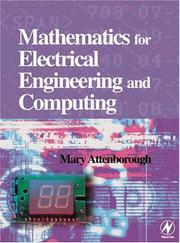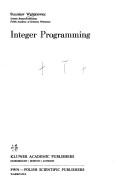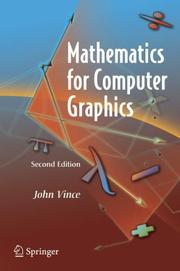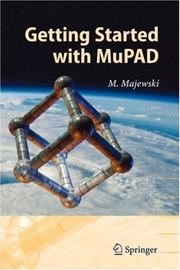| Listing 1 - 10 of 36 | << page >> |
Sort by
|
Book
Year: 1991 Publisher: Washington, D.C. : National Academy Press,
Abstract | Keywords | Export | Availability | Bookmark
 Loading...
Loading...Choose an application
- Reference Manager
- EndNote
- RefWorks (Direct export to RefWorks)
Computer science -- Mathematics. --- Electronic books. -- local. --- High performance computing. --- Computer science --- Mathematics.

ISBN: 1281003034 9786611003036 0080473407 1417505559 075065855X 9780750658553 9780080473406 9781417505555 9781281003034 Year: 2003 Publisher: Oxford ; Burlington, MA : Newnes,
Abstract | Keywords | Export | Availability | Bookmark
 Loading...
Loading...Choose an application
- Reference Manager
- EndNote
- RefWorks (Direct export to RefWorks)
Mathematics for Electrical Engineering and Computing embraces many applications of modern mathematics, such as Boolean Algebra and Sets and Functions, and also teaches both discrete and continuous systems - particularly vital for Digital Signal Processing (DSP). In addition, as most modern engineers are required to study software, material suitable for Software Engineering - set theory, predicate and prepositional calculus, language and graph theory - is fully integrated into the book.Excessive technical detail and language are avoided, recognising that the real requirement for
Computer science - Mathematics. --- Electric engineering - Mathematics. --- Electric engineering--Mathematics. Computer science--Mathematics. --- Electrical engineering --- Computer science --- Electrical Engineering --- Electrical & Computer Engineering --- Engineering & Applied Sciences --- Mathematics --- Mathematics. --- Computer mathematics --- Discrete mathematics --- Electronic data processing --- Engineering mathematics
Book
ISBN: 1280582286 9786613612069 012385492X 0123854911 9780123854919 9780123854926 9781280582288 Year: 2012 Publisher: Amsterdam ; Boston : Elsevier/AP,
Abstract | Keywords | Export | Availability | Bookmark
 Loading...
Loading...Choose an application
- Reference Manager
- EndNote
- RefWorks (Direct export to RefWorks)
Quantum Information Processing and Quantum Error Correction is a self-contained, tutorial-based introduction to quantum information, quantum computation, and quantum error-correction. Assuming no knowledge of quantum mechanics and written at an intuitive level suitable for the engineer, the book gives all the essential principles needed to design and implement quantum electronic and photonic circuits. Numerous examples from a wide area of application are given to show how the principles can be implemented in practice. This book is ideal for the electronics, photonics and computer en
Computer science -- Mathematics. --- Quantum computers. --- Quantum electronics. --- Quantum theory. --- Quantum electronics --- Physics --- Physical Sciences & Mathematics --- Electricity & Magnetism --- Atomic Physics --- Quantum dynamics --- Quantum mechanics --- Quantum physics --- Mechanics --- Thermodynamics --- Computers
Book
ISBN: 9781484250617 1484250613 Year: 2019 Publisher: Berkeley, CA Apress :Imprint: Apress
Abstract | Keywords | Export | Availability | Bookmark
 Loading...
Loading...Choose an application
- Reference Manager
- EndNote
- RefWorks (Direct export to RefWorks)
Employ essential and hands-on tools and functions of the MATLAB and Simulink packages, which are explained and demonstrated via interactive examples and case studies. This book contains dozens of simulation models and solved problems via m-files/scripts and Simulink models which help you to learn programming and modeling essentials. You’ll become efficient with many of the built-in tools and functions of MATLAB/Simulink while solving engineering and scientific computing problems. Beginning MATLAB and Simulink explains various practical issues of programming and modelling in parallel by comparing MATLAB and Simulink. After reading and using this book, you'll be proficient at using MATLAB and applying the source code from the book's examples as templates for your own projects in data science or engineering. You will: Get started using MATLAB and Simulink Carry out data visualization with MATLAB Gain the programming and modeling essentials of MATLAB Build a GUI with MATLAB Work with integration and numerical root finding methods Apply MATLAB to differential equations-based models and simulations Use MATLAB for data science projects.
Programming languages (Electronic computers). --- Mathematical logic. --- Numerical analysis. --- Computer science—Mathematics. --- Programming Languages, Compilers, Interpreters. --- Mathematical Logic and Formal Languages. --- Numeric Computing. --- Symbolic and Algebraic Manipulation. --- MATLAB.

ISBN: 0792307267 9048140684 9401579458 9780792307266 Year: 1991 Volume: 46 Publisher: Dordrecht: Kluwer,
Abstract | Keywords | Export | Availability | Bookmark
 Loading...
Loading...Choose an application
- Reference Manager
- EndNote
- RefWorks (Direct export to RefWorks)
'Et moi, ... , so j'avait su comment en revenir, One service mathematics has rendered the je n'y serais point al!e.' human race. It has put common sense back Jules Verne where it belongs, on the topmost shelf next to the dusty canister labelled 'discarded non The series is divergent; therefore we may be sense'. able to do something with it. Eric T. Bell 0. Heaviside Mathematics is a tool for thought. A highly necessary tool in a world where both feedback and nonlinearities abound. Similarly, all kinds of parts of mathematics serve as tools for other parts and for other sciences. Applying a simple rewriting rule to the quote on the right above one finds such statements as: 'One service topology has rendered mathematical physics ... '; 'One service logic has rendered computer science .. .'; 'One service category theory has rendered mathematics ... '. All armably true. And all statements obtainable this way form part of the raison d'etre of this series.
Integer programming --- 519.854 --- Programming (Mathematics) --- Discrete programming --- 519.854 Discrete programming --- Computer science—Mathematics. --- Operations research. --- Management science. --- Decision making. --- Management. --- Discrete Mathematics in Computer Science. --- Operations Research, Management Science. --- Operations Research/Decision Theory.
Multi
ISBN: 9781484231890 1484231899 Year: 2017 Publisher: Berkeley, CA : Apress : Imprint: Apress,
Abstract | Keywords | Export | Availability | Bookmark
 Loading...
Loading...Choose an application
- Reference Manager
- EndNote
- RefWorks (Direct export to RefWorks)
Familiarize yourself with MATLAB using this concise, practical tutorial that is focused on writing code to learn concepts. Starting from the basics, this book covers array-based computing, plotting and working with files, numerical computation formalism, and the primary concepts of approximations. Introduction to MATLAB is useful for industry engineers, researchers, and students who are looking for open-source solutions for numerical computation. In this book you will learn by doing, avoiding technical jargon, which makes the concepts easy to learn. First you’ll see how to run basic calculations, absorbing technical complexities incrementally as you progress toward advanced topics. Throughout, the language is kept simple to ensure that readers at all levels can grasp the concepts. You will: Apply sample code to your engineering or science problems Work with MATLAB arrays, functions, and loops Use MATLAB’s plotting functions for data visualization Solve numerical computing and computational engineering problems with a MATLAB case study.
Mathematics --- Computer science --- Programming --- Computer. Automation --- Matlab (informatica) --- computers --- informatica --- programmeren (informatica) --- programmeertalen --- wiskunde --- computerkunde --- Programming languages (Electronic computers). --- Computer science—Mathematics. --- Computer programming. --- Programming Languages, Compilers, Interpreters. --- Math Applications in Computer Science. --- Programming Techniques. --- MATLAB. --- Programming languages (Electronic computers)
Multi
ISBN: 9781484251249 1484251245 Year: 2020 Publisher: Berkeley, CA Apress :Imprint: Apress
Abstract | Keywords | Export | Availability | Bookmark
 Loading...
Loading...Choose an application
- Reference Manager
- EndNote
- RefWorks (Direct export to RefWorks)
Harness the power of MATLAB for deep-learning challenges. This book provides an introduction to deep learning and using MATLAB's deep-learning toolboxes. You’ll see how these toolboxes provide the complete set of functions needed to implement all aspects of deep learning. Along the way, you'll learn to model complex systems, including the stock market, natural language, and angles-only orbit determination. You’ll cover dynamics and control, and integrate deep-learning algorithms and approaches using MATLAB. You'll also apply deep learning to aircraft navigation using images. Finally, you'll carry out classification of ballet pirouettes using an inertial measurement unit to experiment with MATLAB's hardware capabilities. You will: Explore deep learning using MATLAB and compare it to algorithms Write a deep learning function in MATLAB and train it with examples Use MATLAB toolboxes related to deep learning Implement tokamak disruption prediction.
Mathematics --- Programming --- Computer architecture. Operating systems --- Artificial intelligence. Robotics. Simulation. Graphics --- Computer. Automation --- I/O (input/output) --- randapparatuur --- computers --- informatica --- externe fixatie (geneeskunde --- programmeertalen --- KI (kunstmatige intelligentie) --- AI (artificiële intelligentie) --- Programming languages (Electronic computers). --- Artificial intelligence. --- Computer input-output equipment. --- Computer science—Mathematics. --- Computer programming. --- Programming Languages, Compilers, Interpreters. --- Artificial Intelligence. --- Hardware and Maker. --- Mathematics of Computing. --- Programming Techniques. --- MATLAB.

ISBN: 1280412194 9786610412198 1846282837 1846280346 Year: 2006 Publisher: London : Springer,
Abstract | Keywords | Export | Availability | Bookmark
 Loading...
Loading...Choose an application
- Reference Manager
- EndNote
- RefWorks (Direct export to RefWorks)
Baffled by maths? Then don't give up hope. John Vince will show you how to understand many of the mathematical ideas used in computer animation, virtual reality, CAD, and other areas of computer graphics. In thirteen chapters you will rediscover - and hopefully discover for the first time a new way of understanding - the mathematical techniques required to solve problems and design computer programs for computer graphic applications. Each chapter explores a specific mathematical topic and takes you forward into more advanced areas until you are able to understand 3D curves and surface patches, and solve problems using vectors. After reading the book, you should be able to refer to more challenging books with confidence and develop a greater insight into the design of computer graphics software. Get to grips with mathematics fast ... • Numbers • Algebra • Trigonometry • Coordinate geometry • Transforms • Vectors • Curves and surfaces • Barycentric coordinates • Analytic geometry Mathematics for Computer Graphics, Second Edition The book you will read once, and refer to over and over again!
Computer graphics --- Mathematics. --- Math --- Science --- Computer science. --- Computer simulation. --- Computer graphics. --- Mathematics of Computing. --- Simulation and Modeling. --- Computer Graphics. --- Math Applications in Computer Science. --- Automatic drafting --- Graphic data processing --- Graphics, Computer --- Computer art --- Graphic arts --- Electronic data processing --- Engineering graphics --- Image processing --- Computer modeling --- Computer models --- Modeling, Computer --- Models, Computer --- Simulation, Computer --- Electromechanical analogies --- Mathematical models --- Simulation methods --- Model-integrated computing --- Informatics --- Digital techniques --- Computer science—Mathematics.
Book
ISBN: 3642414214 3642414222 Year: 2013 Publisher: Heidelberg [Germany] : Springer,
Abstract | Keywords | Export | Availability | Bookmark
 Loading...
Loading...Choose an application
- Reference Manager
- EndNote
- RefWorks (Direct export to RefWorks)
People, problems, and proofs are the lifeblood of theoretical computer science. Behind the computing devices and applications that have transformed our lives are clever algorithms, and for every worthwhile algorithm there is a problem that it solves and a proof that it works. Before this proof there was an open problem: can one create an efficient algorithm to solve the computational problem? And, finally, behind these questions are the people who are excited about these fundamental issues in our computational world. In this book the authors draw on their outstanding research and teaching experience to showcase some key people and ideas in the domain of theoretical computer science, particularly in computational complexity and algorithms, and related mathematical topics. They show evidence of the considerable scholarship that supports this young field, and they balance an impressive breadth of topics with the depth necessary to reveal the power and the relevance of the work described. Beyond this, the authors discuss the sustained effort of their community, revealing much about the culture of their field. A career in theoretical computer science at the top level is a vocation: the work is hard, and in addition to the obvious requirements such as intellect and training, the vignettes in this book demonstrate the importance of human factors such as personality, instinct, creativity, ambition, tenacity, and luck. The authors' style is characterize d by personal observations, enthusiasm, and humor, and this book will be a source of inspiration and guidance for graduate students and researchers engaged with or planning careers in theoretical computer science.
Engineering & Applied Sciences --- Computer Science --- Computational complexity. --- Information theory. --- Communication theory --- Complexity, Computational --- Computer science. --- Computers. --- Computer science --- Mathematics. --- History. --- Computer Science. --- Theory of Computation. --- History of Computing. --- Mathematics of Computing. --- History of Mathematical Sciences. --- Communication --- Cybernetics --- Electronic data processing --- Machine theory --- Informatics --- Science --- Computer science—Mathematics. --- Annals --- Auxiliary sciences of history --- Math --- Automatic computers --- Automatic data processors --- Computer hardware --- Computing machines (Computers) --- Electronic brains --- Electronic calculating-machines --- Electronic computers --- Hardware, Computer --- Computer systems --- Calculators --- Cyberspace

ISBN: 3540286357 3540286756 Year: 2005 Publisher: Berlin ; New York : Springer,
Abstract | Keywords | Export | Availability | Bookmark
 Loading...
Loading...Choose an application
- Reference Manager
- EndNote
- RefWorks (Direct export to RefWorks)
The world of mathematics is probably one of the most fascinating creations of mankind. The world of mathematics with a Computer Algebra System, like MuPAD, is even more fascinating. With MuPAD, we can develop mathematical concepts, explore them and visualize them with just a few simple commands. This book is a gentle introduction to MuPAD - a modern Computer Algebra System. The author introduces MuPAD step by step and shows how we can use it in various areas of mathematics. A large chapter of the book is devoted to the graphical visualization of mathematical concepts ,and MuPAD graphics are also used extensively throughout the rest of the book. Each chapter of the book should be considered as a single workshop for MuPAD beginners. The whole book is a perfect resource for conducting workshops on using Computer Algebra Systems to explore, experiment with, and visualize mathematical concepts.
Mathematics -- Data processing. --- MuPAD. --- Computer Science --- Engineering & Applied Sciences --- Mathematics --- Data processing. --- Multi-Processing Algebra Data Tool --- Mathematics. --- Computer science --- Algebra. --- Functions of real variables. --- Computer software. --- Statistics. --- Mathematical Software. --- Symbolic and Algebraic Manipulation. --- Real Functions. --- Statistics, general. --- Algebra --- Statistical analysis --- Statistical data --- Statistical methods --- Statistical science --- Econometrics --- Math --- Science --- Mathematical analysis --- Software, Computer --- Computer systems --- Computer science—Mathematics. --- Statistics . --- Real variables --- Functions of complex variables
| Listing 1 - 10 of 36 | << page >> |
Sort by
|

 Search
Search Feedback
Feedback About UniCat
About UniCat  Help
Help News
News